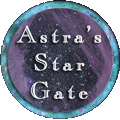

Features: Calendar | Lunar Almanac | Monthly Topic
This Month's Night Sky - NOTE: The next paragraph describes the sky as it appears at 10 pm EST (11 pm EDT) near mid- month. The sky also looks this way at 11 pm EST (midnight EDT) during the beginning of the month and at 9 pm EST (10 pm EDT) by month's end.
Starry Trails:
Suzieastro
Classical Astronomy
The Sky this Month
June brings the summer solstice, also known as mid-summer to the northern hemisphere. The early evening sky is still bright and twilight seems to last forever before the stars of the Summer Triangle bring in the Milky Way and the bright star clouds. The nights are warm for the late night observers, but sadly, they are also short. June 2012 is an exciting time, with a partial lunar eclipse, followed closely by the transit of Venus on June 5-6. The bright planets return to the morning sky, led by Jupiter and Venus. We bid farewell this month to the twins of Gemini, Castor and Pollux. Keep an eye on the evening planets as well because Mars and Saturn are dancing with the bright stars and Mercury in mid-month.
MERCURY appears in the evening twilight by mid-month, passing south of the fading "twin"stars of Castor and Pollux. VENUS puts on her best show this month, a special inferior conjunction when our "sister planet" crosses the solar disk. (See the feature article of the 2012 transit of Venus last month if you missed it.) JUPITER reappears from conjunction with the Sun this month and will be visible during morning twilight, but the angle favors southern hemisphere observers. MARS is now past opposition, the disk will be 7 arc seconds in diameter by the end of the month. It is moving rapidly eastward, passing from Leo into Virgo. It will set around midnight. SATURN is also past opposition this month, but will be visible and well placed in the evening. Can you detect Saturn's retrograde motion, by watching its dance with the first magnitude star Spica?
Calendar of Events
NOTE: For those observers not in the ET zone, convert the calendar times to your zone's time by subtracting one hour for CT, two for MT and three for PT. Don't forget to adjust for Daylight Savings Time when necessary by subtracting one hour from your planisphere's time; dawn and dusk times must also be corrected. See your local newspaper, TV news, or cable TV's Weather Channel for sunrise and sunset times. Unfortunately some of these events may occur during daylight hours in your area.
| DATE | EVENT |
01 |
Saturn and Spica less than 5 degrees apart an 1.25 hours after sunset. Watch these two as they "dance" through the night. |
3 |
Another super moon - - full moon and another lunar eclipse! Again, high tides will occur in coastal areas. |
4 |
Partial eclipse of the Moon occurs, but is only be visible in the early morning when the moon is setting for observers in the Eastern United States. Check NASA's eclipse map for your location. |
5-6 |
Transit of Venus across the disk of the sun. See last month's article for this event. |
7 |
Jupiter 5 deg S of the Pleiades in the early morning sky, visible best from the southern hemisphere. |
15 |
Venus 4 degrees N of Aldebaran. Jupiter and Venus are 10 degs apart just before sunrise. Look for them below the Pleiades. |
17 |
Venus 2 deg S of the Moon. Jupiter and Saturn are 8 degrees apart. Keep an eye on this show. |
20 |
Summer solstice in the northern hemisphere. The days are the longest in the north, but will begin to shorten as the Earth's tilted orbit causes the solar position in the sky to move southward again. |
26 |
Mars 6 deg N of the Moon. |
28 |
Spica 1.4 deg N of the Moon. |
30 |
Venus and Jupiter are 5 degrees apart, located just above Aldebaran in Taurus. (One hour before sunrise.) |
29 |
Pluto at Opposition, oops, I forgot it's not a planet anymore. The New Horizons spacecraft has past the orbit of Uranus and is now over 22 AU away from Earth, its planet of origin. |
| Phases of the Moon | Phase and Date(s) | Best viewed before local midnight |
 |
New |
Deep Space Objects |
 |
1st. Qtr |
Planets & Moon |
 |
Full |
Moon |
 |
Last |
Deep Space & Planets |
Topic of the month: Corona Borealis
|
The summer night sky brings a small constellation to the northern sky, Corona Borealis, the northern crown. It has no first magnitude stars, in fact most members of this constellation are third magnitude stars but its distinct curved pattern was noted by many cultures. The Greeks called it the Crown of Ariadne, the crown that Bacchus gave to his wife Ariadne and placed it in the heavens after she died. The Australian aborigines called it a boomerang, the Greeks saw it as a wreath. This small constellation of stars can be seen in the summer nights between the constellations of Boötes and Hercules. The Welsh called it "Caer Arianrhod," the Castle of the Silver Circle that was the heavenly home of Lady Arianrhod. The Shawnee Indians also had a special myth about Corona Borealis, they called the constellation "The Celestial Sisters". In this legend twelve beautiful maidens came down from the sky in a silver basket to dance and sing. One night they were seen by a mighty hunter named "White Hawk", who tried to capture the youngest and most beautiful of the maidens, but they leaped back into the basket, and were instantly carried up into the sky. The next night White Hawk returned to the spot disguised as a field mouse. As the maidens danced, he resumed his form and succeeded in catching the youngest maiden and took her home as his bride. They lived together and soon they had a son. The maiden was still a member of the sky people and she became homesick. One day she made a silver basket, and singing a magic chant returned to the sky. She is thought to be the brightest star in the crown, second magnitude star Alphecca, also known as Gemma. White Hawk and his son were so sad after she left that the sky people took pity on them a brought them into the sky as well. White Hawk is thought to be represented by the the bright star, Arcturus, in the nearby constellation of Boötes.
The stars of Corona Borealis are readily visible to the naked eye at a dark site on a moonless night, however two members of the modern constellation are not often seen, but have an interesting history. They are variable stars. The first is T Coronae Borealis, also called "The Blaze Star. Normally, a star of 10th magnitude, the Blaze Star has shot up to a brightness that rivalled Gemma. Astronomers noted two occurrences, it reached 2.0 magnitude on May 12, 1866 and 3.0 magnitude on February 9, 1946. T Coronae Borealis is an aging red giant star approximately 2,000 light years away. The second star is R Coronae Borealis, a yellow supergiant star, that has been seen to fade by several magnitudes at irregular intervals. It normally shines around 6 magnitude but at irregular intervals (months or years) it may fade down to magnitude 14. It gradually returns to its normal brightness in a few months. This has earned the star its nickname of "Reverse Nova" or the "Fade-Out star." The star is considered to be a carbon star and it is thought that carbon builds up in the star's atmosphere, causing it to fade in brightness. The carbon gas is blown away eventually by the stellar wind or some other mechanism. The approximate position of these variable stars are noted on the finder chart as "R" and "T." --See You Under the Stars! |
This installment of "Whats Up?" is ©2012 by Dawn Jenkins for Astra's Stargate. View Ron Leeseburg's Farewell Issue
What's Up Home | The Observer's Page
Links to other Stargate Pages:
[ Astronomy ] [ Space ] [ StarWimin ] [ Starfleet ] [ MayaAstro ] [ Observers ]